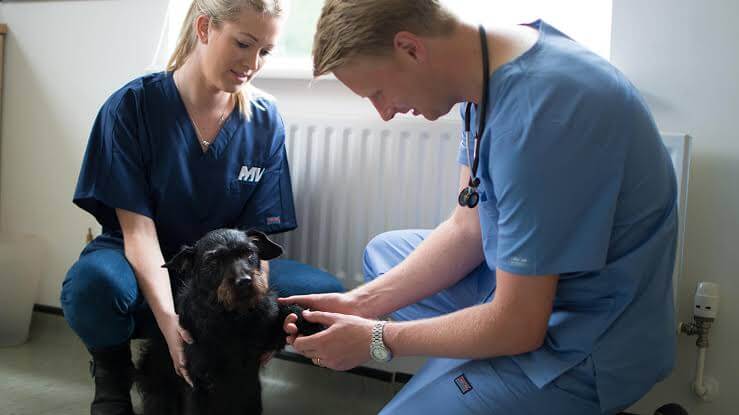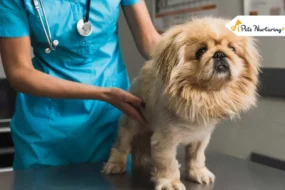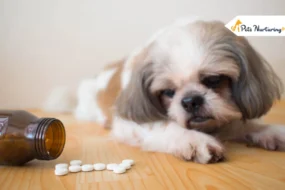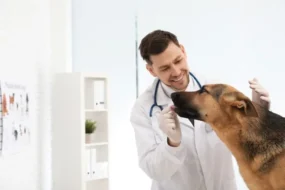
Is your dog stumbling very often nowadays? That isn’t any normal behavior, nor it is misbehaving. This can be a skeletal issue, elbow dysplasia. So here in this blog, I will give you details about the elbow dysplasia in dogs. The article contains detailed information on the issue, starting with its meaning, symptoms, causes, diagnosis, treatment, and at last, its prevention. Hence you can count this article as a health guide for your pooch.
Before starting off, I would like to tell you about the breeds that are prone to this disease genetically or congenitally. The larger dog breeds are most affected by elbow dysplasia.
| Types of Breeds | |
| Chow Chow | Saint Bernard |
| Rottweiler | American Staffordshire Terrier |
| Bernese Mountain Dog | Irish Water Spaniel |
| Black Russian Terrier | Staffordshire Bull Terrier |
| Newfoundland | Bloodhound |
| Chinese Shar-pei | English Setter |
| Fila Brasileiro | Mastiff |
| Dogue de Bordeaux | American Pit Bull Terrier |
| American Bulldog | Bullmastiff |
| German Shepherd | English Springer Spaniel |
What is Elbow Dysplasia in Dogs?
The elbow dysplasia (ED) is a condition where your dog will experience pain and gimpiness in its forelimb. Elbow Dysplasia is basically a development issue of the elbow-joint in a dog or the growth of the cartilage around it.
There are other etiologies, too, that are said to be the reason for the disease occurrence. These causes can befall individually or in conjunction with each other. They are:
- Osteochondritis dissecans (OCD)
- Ununited anconeal process (UAP)
- Fragmented medial coronoid process (FMCP)
- Ununited medial epicondyle (UME)
- Elbow incongruity
The disease can be the result of inheritance. This disease is difficult to diagnose at an early stage. It is subclinical and can be misinterpreted as other skeletal or joint problems. The primary lesion (initial condition of ED) can cause wear & tear and gradually degrade the joint sometimes by disabling or with chronic pain.
If the problem keeps increasing, there are chances that secondary processes like inflammation and osteoarthritis can arise and give rise to other diseases on their own (in short, if measures are not taken as quickly as possible, it will lead to the causes of another disease).
What are the Symptoms of Elbow Dysplasia?
So now you have an idea about dog elbow dysplasia. But what about its symptoms? How will you recognize if your pooch is really suffering from elbow dysplasia or not? You would have noticed the discomfort or pain in its expressions, is it because of this disease?
To clear your doubt, look for the following symptoms in your furry friend:
- Swollen joints,
- Painful expression when there is a movement of forelimbs,
- Difficulty in getting up,
- The lameness getting worse with the exercise,
- Showing negative attitude to go for a walk or a play,
- A decrease in the range of motion of elbows,
- Holding elbows up tightly towards the body.

What are its Causes?
The section is already discussed in the above part. Let’s go for a detailed explanation. The first thing is the dog may get it from its ancestors. But there is another reason behind it too.
There are three bones that together form an elbow joint, namely, the radius, ulna, and humerus. And when there is a problem with any of them or all of them, it results in the type of elbow dysplasia.
The osteochondritis dissecans (OCD) are a joint disorder when diseased cartilage separates from the bone lying under it. It causes severe pain because of the inflammation in the cartilage.
To understand the ununited anconeal process (UAP), you will first have to understand the anconeal process. The process where there is a projection of small bone on the ulna is called the anconeal process. And when this bone doesn’t get attached to the rest of ulna correctly, it results in an ununited anconeal process (UAP).
The fragmented medial coronoid process (FMCP) is a defect in the development of one of the coronoid processes, the two small bone-like structures protruding on the end of the ulna and within the elbow joint resulting in a crack or fissure and separating from the entire bone.
An elbow incongruity is nothing but the misalignment of the joint surfaces of the elbow, resulting in wear of the cartilage.
So any of the above present in the forelimb of the dog is indirectly the cause of elbow dysplasia. They can be hereditary or can be acquired.
How to Diagnose Elbow Dysplasia in Dogs?
You know everything about elbow dysplasia, the disease occurred in dogs. But how to diagnose it? Your first question will be, can it be diagnosed by oneself? Umm.. yes, and no both. You know what the symptoms are, so you can.
And no, because diagnosis is something which will give you the accurate answer, whether your baby pooch is suffering from the ED or not. So if you even have a slight doubt about it, make an appointment with your veterinarian. He/she will help you out with the proper diagnosing.
But what will the vet do? How will he/she examine it? You will be curious to know about the same. And you should know about the procedures or the test the vet will take. Why? So that you don’t panic when the vet is diagnosing the dog.
First, there will be a physical check-up and an in-depth orthopedic exam. The test will include the observations of the dog’s gait and x-ray. An X-ray will help him/her to examine the joint in a better way.
Through radiograph (x-ray), he/she can check for the growth of plates, the conformation of abnormalities, or if there is the presence of any bony-like fragments causing irritation. Your vet may send the report to the expert radiologist for an accurate answer.
There are chances that your pup needs advanced examination like MRI. And the tests may include the usage of needle and syringe to take the sample of fluid from the joint to examine. Testing the fluid will help in knowing about the inflammation or infection that can worsen the situation of the dog.

Treatment of Elbow Dysplasia
Treatment for elbow dysplasia in dogs will be based upon the condition of the dog.
If the condition is mild, then your vet may recommend conservative medical therapy. The common treatment is cleaning the loose flaps, cartilage, or bone. This is possible at the earlier stage only.
But if the condition of your canine is severe then, it may need remedial treatment. If arthritis has set in, then it will become difficult to do, so it is advisable to go for surgical remedy. The common surgical approach is arthroscopy using a fiberoptic scope.
There are rare chances that it will need open-joint surgery from the board-certified doctor, and it isn’t advisable too.
Other than this, there are other options too for treatment like anti-inflammatory drugs (non-steroidal). And long-term use nutraceuticals (fatty acids and glucosamine) can also assist the cure.
Elbow replacement has been developed too. If the condition is too serve and can’t be cured with arthroscopy or open-joint therapy, you can opt for elbow replacement. Elbow replacement is where the infected elbow joint is replaced with the artificial one.
Last but not least, healthy exercise will be recommended by the vet. And for that, he may refer you to a certified canine rehabilitation center nearby, where your dog will have to practice swimming, underwater treadmill, and range of motion exercises.
The healthy exercise sessions may work as the counter strike towards the arthritic elbow, but the balance between the perfect amount and kind of exercise will help in removing the chances of weight gain and muscle atrophy. This both can sprinkle the salt on the existing condition of your dog.
Prevention is Better than Cure
We all know about the famous quote, “prevention is better than cure,” but is it possible in this case too. I would say no (from your end). But you can be careful about selecting the breeder when getting a pup.
The preventions are to be taken by a breeder. Thinking, how preventing elbow dysplasia is a breeder’s job? When a breeder is planning the genetic future of their dogs’ offsprings, he has to make sure that the dog is free from the trait of ED (or any of its type).
Final Word:
If you find symptoms of ED in your dog, take the next appointment from the vet and allow him/her to treat the dog. Most of the dogs respond well to the therapies and are cured using the same. They will live a happy and healthy life ahead. What kind of therapy it will need depends on its age, weight, and severity of the joint.
Have patience, and take decisions practically. If needed, go for the surgery. All that matters is the health of your lovely friend. And if your pooch is already suffering from Elbow Dysplasia and the treatment is going on, it will get well soon. Have faith!
Explore further:











